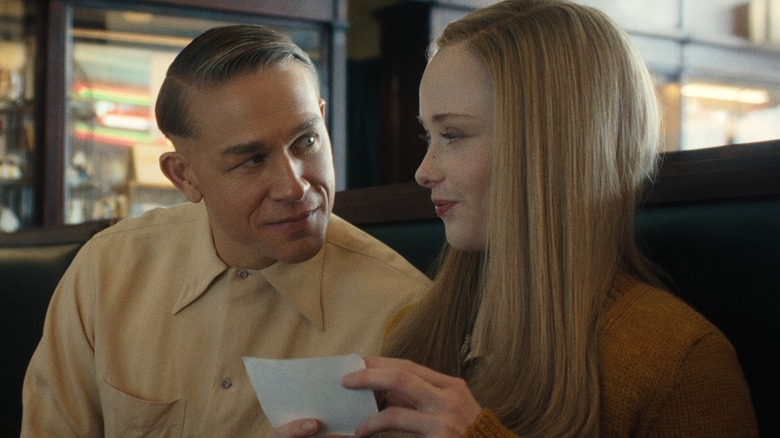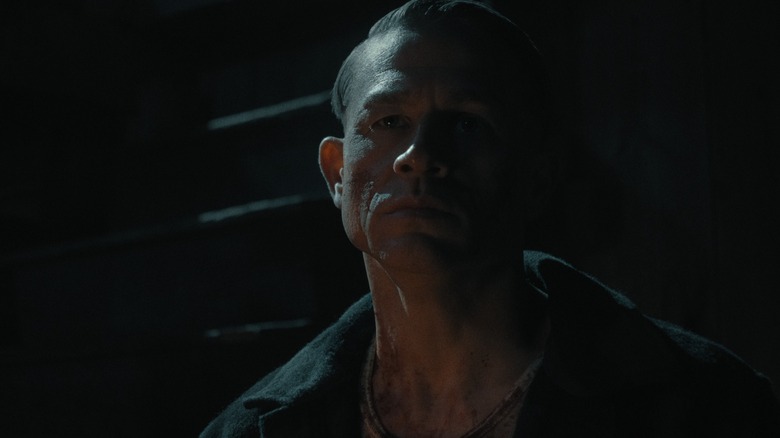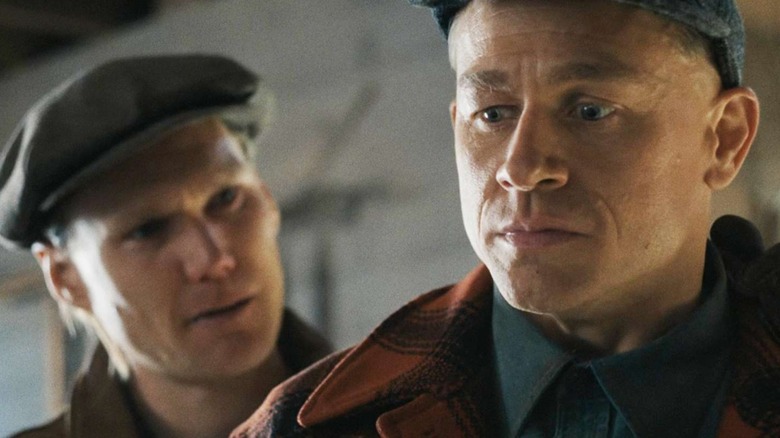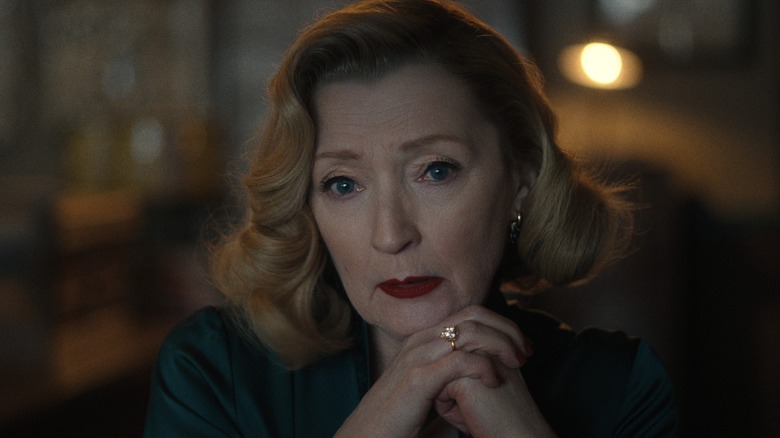Monster: The Ed Gein Story Details That Are Pure Fiction
This post contains major spoilers for "Monster: The Ed Gein Story."
It is not controversial to state that Ryan Murphy has added fuel to the fire of our collective obsession with true crime drama. Both his "Dahmer – Monster: The Jeffrey Dahmer Story" and "Monsters: The Lyle and Erik Menendez Story" were smash hits on Netflix for some reason, having concerningly blurred the line between morbid interest and lurid exploitation. The third installment in the "Monster" anthology, "Monster: The Ed Gein Story," is not a Murphy-helmed endeavor — Ian Brennan ("Glee," "Scream Queens") has decided to take the meta-commentary route to explore the titular murderer/grave robber's influence on pop culture in general. While Murphy's limited involvement as producer might inspire high hopes for a more tactful exploration of the subject matter, "The Ed Gein Story" is perhaps the most morally dubious entry in the "Monster" trilogy.
The new series has all the hallmarks of a Murphy production, where the monster in question, Ed (Charlie Hunnam), is framed through a troubling lens. Sure, the real Gein might've been propelled by complex psychosexual impulses, but the series runs with the most generous assessment of the notorious serial killer by the time the credits roll. Any nuance lurking beneath the surface is wholly lost, as Gein's twisted obsession with female flesh is dangerously conflated with queer identity and expression. This repeated recklessness obscures even the most basic facts, such as the noxious influence Ed's mother (Laurie Metcalf) had on his warped psychosexuality or the ugliness of his general circumstances.
As "Monster: The Ed Gein Story" embellishes a lot for the sake of dramatic stakes, which parts of the story are purely fictional? Let's take a closer look.
There's no proof that Ed Gein killed two hunters on his property
In the Netflix show, Gein is interrupted by two bear hunters (named Victor Travis and Raymond Burgess) while he's mutilating the body of Bernice Worden (Lesley Manville) at the barn on his Plainfield acreage. While the hunters are initially lost in the snow, they stumble upon Gein's shed and discover one of the victims' bodies. On spotting them, Gein chases them into the woods and brutally murders them with a chainsaw. This entire sequence isn't factual, but simply conjecture, as there is no real-life evidence that Gein had anything to do with their deaths.
Now, why does this conjecture exist in the first place? For starters, two hunters named Travis and Burgess did go missing in the local area where Gein lived, but their fates remain unknown to this day. While Gein was questioned about this disappearance, there is no evidence to tie him to the missing hunters. Moreover, the murder by chainsaw approach doesn't fit into the real Gein's modus operandi, and must've stemmed from a horror classic directly inspired by Gein. Yep, Leatherface from Tobe Hooper's "The Texas Chain Saw Massacre" is undoubtedly based on Gein, but the fictional killer's use of chainsaws as murder weapons was Hooper's attempt to up the ante (and the brutality) of the film's premise.
It is worth noting that Gein only confessed to the murders of two women: 54-year-old Mary Hogan and 58-year-old Bernice Worden. He told authorities that he had murdered them because they resembled his dead mother. This means that the show's portrayal of Gein killing babysitter Evelyn Hartley (Addison Rae) is also false, as the real Hartley's disappearance case seems to have no connection to Gein and still remains unsolved.
Gein doesn't seem to have any involvement with his brother's death
In yet another instance of Netflix embellishing facts for dramatic purposes, we see Gein kill his brother Henry (Hudson Oz) by hitting him with a piece of wood and staging a brush fire accident. This incident is presented as a definitive fact, but the reality surrounding Henry Gein's death is a tad more complicated. According to reports, the Gein brothers lived together in Plainfield and carried out the practice of burning marsh vegetation in May 1944, but the fire raged out of control one day, and Henry was soon reported missing. Henry's body was later found, but the reason for his death was chalked up to a tragic accident.
It is only after Gein's arrest that folks started suspecting his direct involvement in Henry's death, although the motives surrounding this supposed crime are based on pure conjecture. In Harold Schechter's "Deviant: The Shocking True Story of the Original 'Psycho," the biographer states that the authorities had initially dismissed foul play, but the official reason of death listed by the coroner was asphyxiation (despite no autopsy being performed). Notable bruises on Henry's head were also taken into consideration, but it is unclear whether he had fallen or been struck. Schechter also noted there were no signs of Henry being injured by the flames, even though his clothes were covered in soot. While these details do raise suspicion, they're not substantial enough to prove or disprove any assumptions.
There's zero evidence of a romantic relationship between Gein and Bernice Worden
We know that Worden was Gein's final victim (at least in terms of the two murders he confessed to), and that she was a Plainfield hardware store owner who had disappeared in November 1957. While the Netflix series sticks to these basic facts, it makes the baffling decision to portray a charged romantic relationship between them, wherein the two also share sexual intimacy. The impetus behind this might've been an urge to highlight Gein's warped view on sexuality that can be traced back to his mother, but the results are unsavory and leave a horrible aftertaste after Worden is brutally killed.
So, what are the facts here? After Worden's real-life disappearance, her son, Deputy Sheriff Frank Worden, led the investigation after finding blood stains on the floor of his mother's hardware store. After a connection was made between Gein's presence inside the store (he accidentally left a receipt behind) and Worden's disappearance soon after, the former's farm was investigated, leading to the discovery of the victim's heavily decapitated and flayed body. As confessed by Gein, the reason why he killed Worden was due to a resemblance to his mother (both in age and appearance). There is no evidence that the two ever had a sexual or romantic relationship of any kind.
Apart from these fictional add-ons, "Monster: The Ed Gein Story" also leaves out crucial real-life details from the story, including the deeply abusive nature of the titular killer's late father. The rest is rather difficult to discern, such as the extent of Adeline Watkins' involvement in Gein's crimes, as the facts surrounding the real Adeline are shrouded in half-truths and retracted statements.
"Monster: The Ed Gein Story" is now streaming on Netflix.



